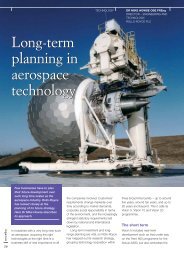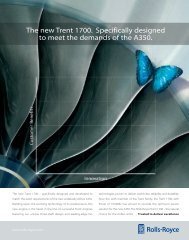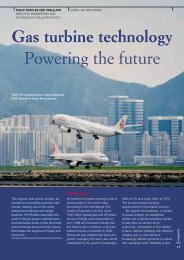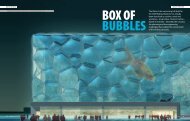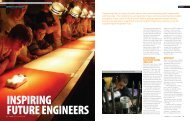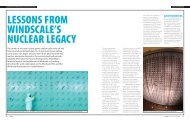Engineering ethics Engineering ethics - Ingenia
Engineering ethics Engineering ethics - Ingenia
Engineering ethics Engineering ethics - Ingenia
Create successful ePaper yourself
Turn your PDF publications into a flip-book with our unique Google optimized e-Paper software.
JOHN UFF CBE QC FREng<br />
NASH PROFESSOR OF<br />
ENGINEERING LAW, KINGS<br />
COLLEGE, LONDON<br />
PROFESSIONAL ISSUES<br />
In the first of a series of three<br />
articles, John Uff looks at the issues<br />
involved when individual engineers<br />
seek to warn the public about<br />
potential and often preventable<br />
disasters. Since these warnings<br />
often constitute unauthorised<br />
disclosure by the engineer or<br />
engineers involved the result is often<br />
the termination of employment.<br />
However, current practice is under<br />
review and is moving towards the<br />
protection of ‘whistleblowers’. Other<br />
means of securing disclosure, such<br />
as confidential reporting systems<br />
and amicus curae action by<br />
Institutions are examined.<br />
The subject of ‘engineering<br />
<strong>ethics</strong>’ is no longer novel: there<br />
is a growing literature, in the<br />
United Kingdom, 1 the Commonwealth 2<br />
and elsewhere in the world, 3<br />
particularly in the USA. 4 The subject<br />
still lacks any generally accepted<br />
definition and its scope remains<br />
uncertain. However, a convenient<br />
summary of the subject’s practical<br />
objectives in the United Kingdom is to<br />
be found in the codes of conduct<br />
promulgated by the UK engineering<br />
<strong>Engineering</strong><br />
institutions, some of which refer<br />
expressly to ethical principles.<br />
While material differences exist<br />
between individual Institutional codes, all<br />
appear directed primarily at the public<br />
interest. The particular interest which<br />
many of the codes highlight is that of<br />
safety, coupled with the avoidance of<br />
damage to the environment. An analysis<br />
of legal obligations owed by individual<br />
engineers shows that the codes<br />
assume or require duties beyond those<br />
which are likely to be directly<br />
enforceable against the engineer,<br />
whether by the immediate client or<br />
others. This situation gives rise to a<br />
<strong>ethics</strong><br />
Some current issues<br />
number of fundamental questions<br />
including: how is a duty involving the<br />
public interest to be enforced; and what<br />
steps are open to individual engineers<br />
when seeking to comply with codes of<br />
conduct? This article addresses the<br />
second of these questions. 5<br />
There appears to be little in common<br />
between developments in engineering<br />
<strong>ethics</strong> in different countries. While no<br />
systematic study has been attempted, it<br />
is evident that developments in the USA<br />
over more then two decades have been<br />
led by court actions involving intervention<br />
or amicus curiae briefs. These<br />
developments are reviewed later in this<br />
ingenia<br />
47
PROFESSIONAL ISSUES<br />
ingenia<br />
48<br />
article. In Canada and Australia,<br />
development has occurred through<br />
disciplinary proceedings brought against<br />
individual engineers. In the United<br />
Kingdom there are few instances of any<br />
such actions and, as yet, nobody of<br />
collective learning or experience to form<br />
the basis of a study of engineering <strong>ethics</strong>.<br />
This is in complete contrast to the field of<br />
medical (now renamed bio-) <strong>ethics</strong>, in<br />
which many cases involving ethical<br />
issues have been brought before Courts<br />
(including the European Court of Human<br />
Rights). In the field of engineering, while<br />
ethical questions can be identified as<br />
arising in many recurrent situations, the<br />
analysis and resolution of such questions<br />
must be approached on an ad hoc<br />
basis, with no more than general<br />
principles as guidance. The importance<br />
of these issues is such that systematic<br />
study and reporting is overdue.<br />
This article addresses the limited and<br />
practical questions involved in actions<br />
by individual engineers seeking to give<br />
warnings of preventable disasters. The<br />
consequences of such unauthorised<br />
disclosure are considered, together with<br />
alternative means of seeking to achieve<br />
disclosure. The article includes a review<br />
of practices, primarily in the USA, in<br />
relation to amicus or intervention<br />
proceedings, usually in consequence of<br />
actions taken by engineers to secure<br />
disclosure in pursuance of a perceived<br />
ethical duty.<br />
Warnings of preventable<br />
disasters<br />
A great deal of the literature published<br />
on engineering <strong>ethics</strong> in the USA is<br />
concerned with the actions of individual<br />
engineers in the face of actual disasters<br />
which can be seen to have been<br />
preventable. Perhaps the most appalling<br />
and thoroughly researched incident was<br />
the loss of the space-shuttle Challenger<br />
in 1986. This followed clear warnings by<br />
engineers from the Morton-Thiokol<br />
company, manufacturers of the solidfuel<br />
booster rockets, as to the danger of<br />
launching the vehicle at low<br />
temperature. The engineers’ warnings<br />
This … raises fundamental issues as to the<br />
actions that ought to be taken by those in a<br />
position to understand fully the implications<br />
of foreseen technical hazards …<br />
were overruled by a management<br />
decision. This case raises fundamental<br />
issues as to the actions that ought to be<br />
taken by those in a position to<br />
understand fully the implications of<br />
foreseen technical hazards. Likewise,<br />
numerous cases concerning the nuclear<br />
industry, airlines, the motor industry and<br />
most other branches of engineering,<br />
have provided a rich source of practical<br />
materials, forming the basis of the study<br />
and indeed the teaching of engineering<br />
<strong>ethics</strong> in the USA.<br />
The UK has suffered its share of<br />
engineering disasters. Few have given<br />
rise to issues comparable to the spaceshuttle<br />
Challenger. Many, however, have<br />
revealed deep-seated management<br />
problems, particularly a succession of<br />
serious railway accidents which have<br />
been fully investigated and reported. 6<br />
All such accidents can be seen to have<br />
been preventable in hindsight, often by<br />
the timely intervention of professional<br />
engineers. In 1991, The Royal Academy<br />
of <strong>Engineering</strong> (then the Fellowship)<br />
published proceedings of a conference<br />
on ‘Preventing Disasters’; this included<br />
‘draft’ guidelines for warnings of<br />
preventable disasters. The guidelines<br />
were offered to the professional<br />
Institutions for consideration. 7 The<br />
guidelines note that engineers:<br />
‘are placed under a professional duty<br />
to uphold the safety of the public and<br />
the environment by the code of<br />
conduct of their Institutions and<br />
organisations. A reciprocal<br />
responsibility is placed on the<br />
Institutions and organisations to assist<br />
any member who turns to them for<br />
help in furthering this duty…’.<br />
The guidelines state that many<br />
organisations have established<br />
procedures and that engineers should<br />
work within those procedures where<br />
they exist. The guidelines emphasise the<br />
need for the engineer to stay within his<br />
or her existing framework of<br />
responsibility by passing on warnings to<br />
others in a position to take action and to<br />
those ultimately responsible for resolving<br />
the situation. Individual engineers are<br />
encouraged to consult others or obtain<br />
guidance from the relevant chartered<br />
engineering institution. The notes state<br />
that informal warnings should be<br />
followed by a formal written statement<br />
and that this process may involve senior<br />
executives or ministers. Guidelines and<br />
notes are, however, infused with concern<br />
about legal liability as well as<br />
confidentiality. 8 The document<br />
represents an important if somewhat<br />
circumscribed recognition of the action<br />
that individual engineers should take in<br />
practice, given the practical constraint of<br />
working in an employed role.<br />
The papers published in the volume<br />
of proceedings bear out the complexity<br />
of any real life situation in which an<br />
engineer is faced with the burden of<br />
passing on a warning of perceived<br />
danger. The papers indeed demonstrate<br />
the way in which even well-expressed<br />
principles and guidance can be of little<br />
assistance when faced with the need for<br />
practical action. The most valuable<br />
contribution to the collection is a paper<br />
by the late Dr Edmund Hambly FREng, 9<br />
describing two situations in which, as an<br />
independent consultant, he had been<br />
driven to act. He describes the<br />
difficulties that lay in the path of<br />
attaining appropriate action, inevitably<br />
involving serious economic<br />
consequences. Dr Hambly’s examples<br />
concerned major structures where,<br />
largely through the effect of carefully
PROFESSIONAL ISSUES<br />
considered action, appropriate remedial<br />
steps were taken in time to avert<br />
disaster. The papers contain other<br />
examples of warnings delivered, but<br />
acted on too late, including the case of<br />
High Alumina Cement (HAC) on which<br />
Professor A.M. Neville CBE FREng had<br />
given clear published warnings in the<br />
1960s. Despite this, a series of<br />
collapses in the 1970s still took the<br />
industry and the public by surprise.<br />
The issue of warning of preventable<br />
disasters has also been considered by<br />
the Standing Committee on Structural<br />
Safety (SCOSS). 10 The 13th Report of<br />
SCOSS issued in May 2001 includes a<br />
section on duties to warn and to heed<br />
warnings, which are to be regarded as<br />
essential elements in ensuring structural<br />
safety. The Royal Academy of<br />
<strong>Engineering</strong> Draft Guidelines for<br />
warnings of preventable disasters are<br />
endorsed by the SCOSS report, which<br />
discusses three types of situation in<br />
which professional engineers can find<br />
themselves under a duty to warn or to<br />
heed warnings. These are:<br />
1 when the engineer is part of a group<br />
of professionals, where warnings<br />
should be given to the group;<br />
2 when the engineer has direct<br />
responsibility for the relevant work,<br />
either by checking or certifying the<br />
design or construction or monitoring<br />
the structure;<br />
3 in more complex situations such as<br />
where a warning has been given to<br />
an appropriate person but is being<br />
ignored; where the control of the<br />
unsafe structure is out of the<br />
engineer’s direct responsibility;<br />
where the engineer is a member of<br />
the public; or where an unsafe<br />
situation has passed but could recur<br />
or arise elsewhere.<br />
It is emphasised that in all these<br />
situations the engineer must deal with<br />
each of the questions:<br />
●<br />
●<br />
●<br />
●<br />
whether to warn<br />
when to warn<br />
who to warn<br />
how to warn.<br />
The report points out that there is a<br />
corresponding duty on persons to heed<br />
warnings both in the immediate and in<br />
the long term, and also to consider the<br />
significance of warning in relation to<br />
other projects. The question of warning<br />
of preventable disasters gives rise to<br />
many further issues, some of which are<br />
now considered.<br />
Consequences of<br />
unauthorised disclosure<br />
If an engineer takes it upon him- or<br />
herself to deliver a warning to the public<br />
in relation to issues of safety or<br />
environment, they expose themselves to<br />
personal risks beyond the threat of legal<br />
proceedings.The actions by engineers in<br />
such circumstances have given rise to<br />
major activity in the field of engineering<br />
<strong>ethics</strong> in the USA. There are many<br />
reported cases of engineers acting in a<br />
responsible manner, assuming the<br />
existence of a duty to warn members of<br />
the public, and of suffering personal<br />
hardship in consequence, frequently<br />
through being victimised as<br />
‘whistleblowers’. While extensive state<br />
and federal legislation exists in the<br />
USA, 11 publications on ethical issues<br />
report numerous cases of hardship<br />
following loss of employment and other<br />
forms of victimisation. It is abundantly<br />
clear from the American experience that<br />
engineers acting in pursuit of a<br />
supposed public duty are not<br />
necessarily perceived as heroes and<br />
there seem few instances of appropriate<br />
recognition being accorded to them. 12<br />
In England relief is now available in<br />
such circumstances through the Public<br />
Interest Disclosure Act 1998. 13 The Act<br />
prohibits dismissal in relation to certain<br />
disclosures defined as ‘qualifying<br />
disclosures’. These include information<br />
which, in the reasonable belief of the<br />
employee, tends to show one or more<br />
of the following:<br />
1 that a criminal offence is being<br />
committed<br />
2 that a person is failing to comply<br />
with a legal obligation<br />
3 that a miscarriage of justice is<br />
occurring<br />
4 that the health or safety of an<br />
individual is being endangered<br />
5 that the environment is being<br />
damaged<br />
6 that information is being concealed.<br />
A qualifying disclosure is a ‘protected<br />
disclosure’ when made in accordance<br />
with the procedure under the Act. In<br />
most cases the employee is obliged to<br />
go first to his employer but in some<br />
circumstances may go over his head.<br />
These include where the worker<br />
reasonably believes he will suffer a<br />
detriment if he goes to the employer or<br />
that evidence will be concealed. Going<br />
direct to the public might also be<br />
justified where the matter is of an<br />
exceptionally serious nature. Where a<br />
disclosure is protected the employer is<br />
prohibited from subjecting the<br />
employee to detriment, dismissing him<br />
or making him redundant on the<br />
grounds of the disclosure. The Act<br />
follows experience in the USA which, as<br />
noted above, has not been wholly<br />
successful in preventing victimisation of<br />
‘whistleblowers’. The effect of the<br />
English Act remains to be established.<br />
Other means of securing<br />
disclosure<br />
The importance of disclosure, and the<br />
adverse consequences which may flow,<br />
dictate that all other avenues should be<br />
explored to find more satisfactory<br />
means of passing on significant<br />
information. The most useful<br />
procedures presently available take the<br />
form of limited confidential reporting<br />
systems. Such reporting does not<br />
guarantee either publicity or action, but<br />
does have the advantage of informality<br />
and avoids accusations of disloyalty.<br />
The 13th Report of SCOSS noted the<br />
existence of proposals for a confidential<br />
reporting system for the construction<br />
industry and that such systems had<br />
been developed in other sectors,<br />
particularly in air transport 14 and in<br />
shipping. 15 A confidential reporting<br />
ingenia<br />
49
PROFESSIONAL ISSUES<br />
ingenia<br />
50<br />
system has been set up for the Rail<br />
Industry, initiated by the University of<br />
Strathclyde and subsequently adopted<br />
across the whole network as a result of<br />
government initiatives and public<br />
enquiries. In the wake of the highly<br />
publicised Ladbroke Grove accident in<br />
October 1999, the Confidential Incident<br />
Reporting and Analysis System (CRIAS)<br />
was regarded as a crucial element in the<br />
maintenance of safety on the railways<br />
and of regaining public confidence.<br />
Although the system is now well<br />
established there is, as yet, no indication<br />
of a measurable affect on statistical<br />
trends in the incidence of accidents.<br />
Indeed, the nature of confidential<br />
reporting systems is such that they are<br />
unlikely to prove an appropriate vehicle<br />
for dealing with major shortcomings in<br />
design or management.<br />
At a different level, SCOSS itself<br />
welcomes warnings from engineers<br />
relating to long-term dangers, which it<br />
may pursue. However, where an<br />
engineer becomes aware of facts which<br />
might lead to imminent disaster there is<br />
little alternative to the more direct<br />
procedure discussed above and<br />
illustrated by the examples quoted from<br />
the paper by Dr Hambly.<br />
Amicus action by<br />
Institutions<br />
Given the difficulties faced by individual<br />
engineers in regard to disclosure, it is to<br />
be expected that the Institutions will<br />
A confidential reporting system has been set up for the rail industry, initiated by<br />
the University of Strathclyde and subsequently adopted across the whole<br />
network as a result of government initiatives and public enquiries<br />
themselves consider action in support<br />
of engineers who do publish warnings.<br />
As a result of pioneering activities within<br />
the <strong>ethics</strong> movement in the USA, it<br />
seems that such action is available in<br />
the form of amicus curiae or<br />
intervention proceedings in an existing<br />
court action relating to the issue. The<br />
existing action has usually comprised<br />
action by the engineer following<br />
dismissal, but it might also involve<br />
proceedings against the engineer, as<br />
already discussed, to restrain<br />
disclosure. The purpose of amicus or<br />
intervention proceedings is to afford to<br />
the Institution, or other appropriate<br />
body, the opportunity of placing<br />
material before a Court, which supports<br />
the actions of the engineer and upholds<br />
the public interest.<br />
Amicus curiae means literally a<br />
‘friend of the Court’. Historically, this<br />
title referred to those individuals and<br />
entities who were independent of the<br />
parties and who provided advice and<br />
information to the Court in particular<br />
cases. In England, the Courts have<br />
retained this more traditional notion of<br />
amicus curiae and in most cases<br />
restrict amicus submissions to those<br />
requested by the Court, although the<br />
request may be at the instigation of one<br />
of the parties. A Guidance<br />
Memorandum has recently been issued<br />
by the Attorney General and the Lord<br />
Chief Justice on requests for the<br />
appointment of what is now (since the<br />
abolition of Court Latin) renamed an<br />
‘Advocate of the Court’. 16 Since the<br />
original term remains more generally<br />
understood, it will be retained here.<br />
Frequently, the Court requests an<br />
amicus curiae to advise on an issue of<br />
law but, of particular relevance to this<br />
article, it may also request information<br />
on issues of fact and expertise. 17<br />
English Courts also have the discretion<br />
to permit additional parties to<br />
‘intervene’ in litigation where they<br />
demonstrate a sufficient interest in the<br />
proceedings but these parties are not<br />
considered amicus curiae. 18 It may be<br />
noted that the term ‘intervener’ and<br />
‘amicus curiae’, are beginning to fuse in<br />
other jurisdictions with the growth of<br />
outside intervention in litigation.<br />
One of the earliest examples of<br />
intervention or amicus curiae in the field<br />
of engineering occurred in the<br />
celebrated case of Holger Hjortsvang v<br />
San Francisco Bay Area Rapid Transit<br />
District, 19 brought in the State Court of<br />
California. The US Institute of Electrical<br />
and Electronics Engineers (IEEE) was<br />
granted leave to file an amicus brief on<br />
behalf of three engineers who were<br />
sacked for ‘whistle blowing’. The plaintiff,<br />
with two colleagues, had expressed
PROFESSIONAL ISSUES<br />
concerns about the safety of the Rapid<br />
Transit System to the Board. Their<br />
concerns were dismissed, but not long<br />
afterwards, a BART train malfunctioned<br />
because of the problem pointed out by<br />
the engineers, and overran a station,<br />
injuring passengers. The engineers<br />
brought proceedings against their former<br />
employer in which the IEEE intervened.<br />
The petition to the Court stated that:<br />
‘California Courts recognise this<br />
principle and discretion should be<br />
liberally applied to favour Amicus<br />
Curiae intervention. The Court has<br />
broad discretion to permit the filing<br />
of an Amicus Curiae brief…because<br />
IEEE has a particular expertise with<br />
respect to engineers’ obligation to<br />
provide public safety’.<br />
The case settled and shortly afterwards<br />
the IEEE set up a formal amicus curiae<br />
review mechanism whereby engineers<br />
could request the IEEE to file an amicus<br />
brief in a particular case when an ethical<br />
question was raised. 20 This procedure is<br />
now provided for in the Institute’s Policy<br />
and Procedures Manual, which provides<br />
that the amicus statements submitted<br />
to the Court will be those judged ‘to be<br />
objective, verifiable and properly coming<br />
within the purview of the IEEE’. 21 After<br />
over twenty years in operation, twentythree<br />
amicus requests have been made<br />
to the IEEE under this mechanism, but<br />
for varying reasons (including<br />
settlement) none of these requests have<br />
led to the filing of amicus briefs in ethical<br />
support cases. Even so, there is much<br />
to learn from IEEE’s experience.<br />
After more than two decades<br />
following the BART case, experience in<br />
the USA has seen a blurring of the line<br />
between intervener and amicus,<br />
coupled with an exponential increase in<br />
the use of such briefs. This was the<br />
impetus behind several Federal and<br />
State Courts prescribing the manner in<br />
which such briefs were to be submitted.<br />
At the Federal level in the United States,<br />
the amicus practice is now regulated by<br />
procedural rules which require that<br />
private entities and individuals seeking<br />
to participate in a case as amicus curiae<br />
must either gain the consent of all<br />
parties or, if such consent is refused, file<br />
a request with the Court which<br />
describes the applicant’s interest in the<br />
case and whether any portion of the<br />
brief was authored or funded by a<br />
party. 22 This separation of the lobbyist<br />
brief from the true amicus brief is now<br />
essential when it is considered that<br />
amicus filings before the United States<br />
Supreme Court have increased eightfold<br />
in the last fifty years and that<br />
amicus briefs were filed in over 85% of<br />
all Supreme Court cases in the period<br />
1985 to 1996. 23<br />
There is, as yet, no similar<br />
development within the UK, which is<br />
still at an early stage in considering the<br />
usefulness of amicus briefs in aid of the<br />
maintenance of ethical standards. The<br />
experience from the USA indicates that<br />
caution will be required when seeking<br />
to establish appropriate procedures and<br />
that there will be a need to distance<br />
true ethical considerations from the<br />
interests of pressure groups.<br />
Conclusions<br />
This article has examined a limited<br />
number of current issues concerning the<br />
taking of direct action in response to<br />
perceived ethical duties in engineering. It<br />
is evident that engineering <strong>ethics</strong>, as<br />
currently developed in the United<br />
Kingdom, offers no complete solution<br />
and such remedies as can be identified<br />
raise other problems in their wake.<br />
Underlying all these difficulties is not<br />
merely a lack of established principles,<br />
but a fundamental dichotomy between<br />
the legal duties and responsibilities<br />
taken on by engineers, primarily to their<br />
clients, including duties of confidentiality,<br />
and the wider role in which the actions<br />
of engineers affect the public at large.<br />
Finding solutions to the many<br />
problems that can arise dictates action<br />
at several levels. While this article has<br />
addressed primarily the position of<br />
individual engineers, the role of their<br />
Institutions, which must take primary<br />
responsibility for promulgating codes of<br />
conduct, is of great importance and<br />
equally in need of definition. The<br />
importance of the subject is nowhere<br />
more clearly demonstrated than in the<br />
actions of individual engineers who<br />
seek to uphold the public interest by<br />
taking individual actions in disregard of<br />
their personal interest. The profession<br />
owes them a duty to learn appropriately<br />
from their actions. ■<br />
This is the first of a series of three<br />
articles that will appear in <strong>Ingenia</strong>.<br />
The second article will<br />
examine some specific ethical<br />
questions that engineers may<br />
encounter, and discuss the rules<br />
and principles through which<br />
appropriate action may be<br />
determined, having due regard to<br />
legal duties.<br />
The third article will consider<br />
the position of the Institutions who<br />
promulgate, and are assumed to<br />
review and enforce, codes of<br />
professional conduct intended to<br />
regulate the actions of their<br />
members.<br />
References<br />
1 ‘Ethics in <strong>Engineering</strong>’, Brian<br />
Tomkins and Ian Howard, <strong>Ingenia</strong><br />
Nov 2001, p65; ‘Preventing<br />
Disasters’, proceedings of a<br />
conference organised by the<br />
Fellowship (now Royal Academy) of<br />
<strong>Engineering</strong>, 1991. ‘The morality of<br />
safety’, PAD Sheen, <strong>Engineering</strong><br />
Management Journal, April 1999.<br />
Academic work in the UK is<br />
undertaken at the universities of<br />
Surrey and Bath.<br />
2 <strong>Engineering</strong> <strong>ethics</strong> in Canada is<br />
subject to separate provincial<br />
statutes. The professional body for<br />
Ontario publishes reports of<br />
disciplinary hearings. There are also<br />
a number of Federal bodies. The<br />
Institution of Engineers in Australia<br />
operates on a national basis and<br />
has an established code of <strong>ethics</strong>,<br />
together with detailed enforcement<br />
procedures.<br />
ingenia<br />
51
PROFESSIONAL ISSUES<br />
ingenia<br />
52<br />
3 An international conference on<br />
‘Research in Ethics and <strong>Engineering</strong>’<br />
was held in Delft in April 2002 with<br />
papers presented from universities<br />
in Sweden, Holland, Germany,<br />
Israel, UK and USA.<br />
4 For a general review and list of<br />
further authorities see Ronald R<br />
Klein, ‘Ethical Issues in<br />
<strong>Engineering</strong>: Beyond Disaster<br />
Ethics’ (2000) at<br />
http://www3.itu.edu.tr/~sosbil/Scie<br />
ncesemnars2.html. Several US<br />
websites contain extensive<br />
bibliographies as well, including<br />
those of the National Society of<br />
Professional Engineers (NSPE) at<br />
http://www.nspe.org/<strong>ethics</strong>/eh5-<br />
rel.asp and the Online Ethics<br />
Center for <strong>Engineering</strong> and Science<br />
at http://online<strong>ethics</strong>.org/.<br />
5 Both questions are addressed in<br />
the paper ‘<strong>Engineering</strong> Ethics: Do<br />
Engineers owe duties to the<br />
public?’, delivered as the Lloyd’s<br />
Register lecture to The Royal<br />
Academy of <strong>Engineering</strong>, 22 April<br />
2002. This article is based on part<br />
of the lecture.<br />
6 These include the public enquiries<br />
into the railway accidents at<br />
Clapham Junction (1988), Southall<br />
(1997) and Ladbroke Grove (1999).<br />
7 The institutional rules quoted above<br />
are those current at the date of this<br />
article. In most cases no significant<br />
amendments have been made<br />
since The Academy draft.<br />
8 The document itself ends with a<br />
complete disclaimer on behalf of<br />
the Fellowship.<br />
9 FREng, subsequently President of<br />
ICE.<br />
10 The Standing Committee was<br />
established jointly between the<br />
Institutions of Civil and Structural<br />
Engineers (and Municipal Engineers<br />
before their merger) following the<br />
partial collapse at Ronan Point,<br />
Newham, in 1968.<br />
11 Whistleblower protection on the<br />
federal level in the US is scattered<br />
throughout various statutes,<br />
including the environmental laws<br />
(such as Superfund, 42 U.S.C.<br />
9610, the Water Pollution Control<br />
Act, 33 U.S.C. 1367, and the<br />
Atomic Energy and Energy<br />
Reorganization Acts, 42 U.S.C.<br />
5851), the employment laws (such<br />
as the Occupational Safety and<br />
Health Act, 29 U.S.C. 660(c), the<br />
Federal Mine Health and Safety Act,<br />
30 U.S.C. 30 U.S.C. 815 (c) (1977)<br />
and the National Labor Relations<br />
Act, 29 U.S.C. 158(a)(4)), and in a<br />
number of other subject areas.<br />
12 For example, see Rachel Davis,<br />
‘For Whistleblowers, Ethical Mile is<br />
a Hard Walk’ (March 2001) at the<br />
NSPE website at<br />
http://nspe.org/etweb/13-<br />
01feature.asp and Walter Elden,<br />
‘Curtailing Ethical Harassment’<br />
(February 1996) at the IEEE<br />
website at<br />
http://caffeine.ieee.org/INST/feb96/<br />
<strong>ethics</strong>.html.<br />
13 By insertion of a new Part IV A of<br />
the Employment Rights Act 1996.<br />
14 Tait P ‘Confidential Reporting in the<br />
UK Commercial Air Transport<br />
Industry’, HSE Seminar, 1998.<br />
15 Beedel R ‘International Marine<br />
Accident Reporting Scheme:<br />
Lessons from MARS’ Conference’,<br />
London, October 1999.<br />
16 Published in Counsel, February<br />
2002 with an explanatory article by<br />
the Attorney General.<br />
17 Under English Law, there is no<br />
settled rule as to whether amicus<br />
curiae can place evidence before the<br />
Court. See Gaskill v Gaskill [1921]<br />
p425 and Keys v Keys [1921] p204<br />
but see also Re: H per Booth.<br />
However, the Court’s very request<br />
for factual information indicates that<br />
the amicus filing will be considered<br />
as evidence by the Court.<br />
18 In the recent and widely publicised<br />
Pinochet case, the Divisional Court<br />
and the House of Lords permitted<br />
Amnesty International to intervene<br />
as an interested party – an<br />
intervener, as well as appointing an<br />
amicus curiae to assist the Court R<br />
v Bow Street Magistrates ex. parte<br />
Pinochet Ugarte [1998] 4 AER 897.<br />
19 Walter Elden, ‘Curtailing Ethical<br />
Harassment’, on the IEEE website at<br />
http://caffeine.ieee.org/INST/feb96/e<br />
thics.html.<br />
20 Walter Elden, ‘IEEE’s Member<br />
Conduct Committee – 20 Years of<br />
Operation’ at<br />
http://www.spectrum.ieee.org/INST<br />
/feb98/conduct.html.<br />
21 IEEE Policy and Procedures<br />
Manual 7.13 ‘Preparation and Filing<br />
of Amicus Curiae Briefs’ at<br />
http://www.ieee.org/about/whatis/p<br />
olicies/p7-13.html.<br />
22 SUP.CT.R.37 and FED. R.APP.<br />
p29. Many of the State Courts in<br />
the United States also have rules<br />
permitting the submission of<br />
amicus requests. However, the<br />
rules vary and in some cases are<br />
much more restrictive than Federal<br />
Court practice. For a sampling of<br />
State Court practice, see Nancy<br />
Bage Sorenson, ‘The Ethical<br />
Implications of Amicus Briefs’<br />
(1999) 30 St. Mary’s LJ 1219.<br />
23 Joseph Kearney, ‘The Influence of<br />
amicus curiae Briefs on the<br />
Supreme Court’ (2000) 148 U.PA.<br />
L. REV. 743, 752–753.<br />
John Uff worked in civil and<br />
geotechnical engineering, retraining<br />
to specialise in construction and<br />
engineering law. He has been<br />
involved in many international<br />
disputes, covering many parts of<br />
the world, most recently in<br />
Australia. In 1987 he became the<br />
founding<br />
Director of the<br />
Centre of<br />
Construction<br />
Law at Kings<br />
College,<br />
London, where<br />
he has held the<br />
Nash Chair of <strong>Engineering</strong> Law<br />
since 1992. The Centre teaches a<br />
Masters course to engineers and<br />
lawyers. Since 1996 he has chaired<br />
a number of Public Inquiries into<br />
the water industry and railways.



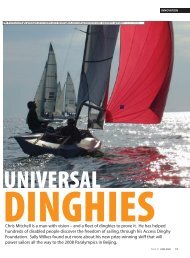

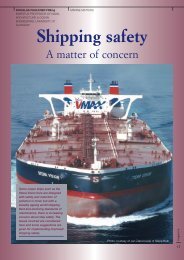
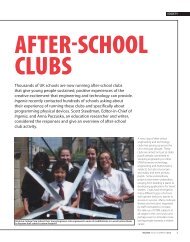
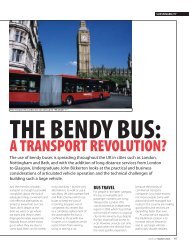
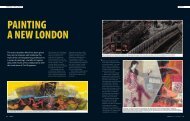
![[322/03] Francke - Ingenia](https://img.yumpu.com/23411337/1/184x260/322-03-francke-ingenia.jpg?quality=85)

